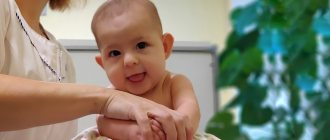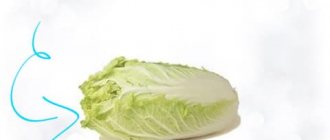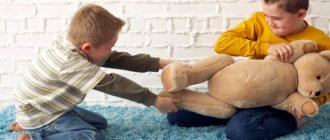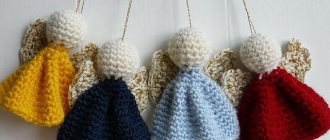Child development at 9 months - by the beginning of the ninth month, dramatic changes in the child’s behavior and development are noted. Not a trace remains of his chubby legs, arms and clumsiness. He no longer looks like the little boy he used to be. Now he is distinguished by curiosity, mobility and the desire to explore a new and interesting world around him. The baby spends a lot of time crawling and playing. It becomes easier for the mother, since she does not need to constantly carry the child in her arms; now she just needs to put the baby in a playpen or on a development mat and keep him in sight, while simultaneously going about her business and communicating with him.
The development of a nine-month-old baby is more aimed at strengthening the muscular and skeletal system.
They continue to intensively improve in order to prepare the toddler’s body for upright walking. Active psychological development is also observed, preparing the baby to utter the first words that parents so expect from him. [Hide]
Physical development of a child at 9 months
Since the baby at the age of nine months becomes very active, he begins to gain less weight than before, when physical activity was minimal.
During the ninth month, the baby will gain weight from 300 to 500 grams and grow from 1 to 2 centimeters. By the end of the month, the child’s parameters will be as follows. Weight will be from 8.5 to 9.5 kilograms, and height from 69.5 to 72.5 centimeters.
Physiological development of a child at 9 months
In just one month of his life, the baby has grown a little, stretched upward, and the volume of his head and chest has increased by half a centimeter.
You can find out how the physiological parameters of a nine-month-old child have changed from this table:
| Girls | Boys | |
| Weight | 7 – 10.5 kg | 7.3 – 11 kg |
| Height | 66 – 75 cm | 67.8 – 76.5 cm |
| Head circumference | 42.9 – 46.4 cm | 44 – 47.4 cm |
| Chest circumference | 44.5 – 49.3 cm | 44.4 – 50.8 cm |
Most children already have 6–8 teeth by 9 months. The lateral and central incisors are added to the existing teeth (first they appear on the lower jaw, then on the upper).
Growing teeth can cause physical discomfort in the baby (pain, fever), worsen his sleep and appetite, and make the child nervous and capricious.
You will see that the baby is trying to relieve pain and speed up the teething process by putting all objects in his mouth.
Don't interfere with this, just replace the item that you think is unsuitable with a rubber toy or a special silicone cooling ring.
Skills and abilities of a child at 9 months
A nine-month-old child sits independently and can remain in a sitting position for up to 10 minutes. When sitting, he can reach and play with toys.
The baby can stand up and hold onto the support for a while. He walks well in a walker and can walk holding onto a chair, slowly moving it forward. While the child can only walk for a short time, after a few more months he will be able to walk without support, increasing the walking time to half an hour. The child likes to jump and squat while in a crib or playpen. The baby crawls well. True, he is still doing this on his belly, since crawling on all fours is still difficult for him. If your baby isn't very good at crawling, there's no need to worry. It is enough to do special exercises with him that will not only help develop crawling skills, but will also allow you to consolidate them in practice.
A nine-month-old child uses the pinching technique, that is, he grabs objects of interest first with two or three fingers, and only then with his entire palm. At this stage, the child’s fine motor skills are improving, he tries to touch everything and stick his fingers wherever possible, as he experiences genuine interest in literally everything he sees. The child can already tear paper into pieces and confidently hold toys or other objects in his hands. This could be food, a cup, a spoon, etc. The baby can clench his fingers without difficulty, but he still has problems unclenching them. For this reason, if a toddler grabs an object, it will be very difficult to take it away from him. When parents try to take a held object away from a child, parents will be met with denial, pushing away their hands, and crying.
At nine months of age, your baby is still teething, and some babies are just starting to. This process is accompanied by moodiness, nervousness, increased temperature and drooling. There is no need to worry if your teeth have not yet begun to cut. They may appear a little later and be cut out immediately in pairs from above or below.
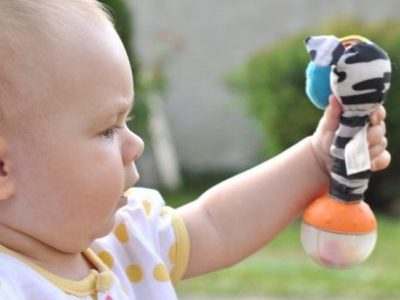
The baby is 9 months old. Development and education of a nine-month-old child
WHAT SHOULD A CHILD BE ABLE TO KNOW AT 9 MONTHS?
9th month baby: Manual dexterity
The child’s memory is actively developing, his movements become more accurate and dexterous. He already knows about the purpose of many objects and the manipulations that can be performed with these objects. Therefore, his actions become more and more purposeful. His favorite activity of all is opening various cabinets and drawers and removing contents from them, especially in the kitchen. Therefore, it is better not to let the little fidget out of your sight for a minute.
Physical development and motor activity of a nine-month-old child
The baby's fine motor skills improve. He plays with objects of different sizes and shapes, presses buttons, takes them apart, opens and closes lids. At this stage, the toddler already knows how to clap his hands.
Having learned to stand at the support, he tries to take the first steps and slowly move sideways along the support. He can also move from object to object, holding onto them alternately. But movement on all fours has been brought to perfection. Thus, the baby explores all corners of the house. When he encounters obstacles, he tries to overcome them in every way available to him: crawls, creeps, crawls. In addition, he is able to climb onto steps, sofas, chairs and even the back of them. But he still can’t go down. When moving, the child studies the spatial relationship of objects.
Useful tips for the mother of a nine-month-old baby
1. Do not leave your baby alone, even if he is playing peacefully with toys and, at first glance, is not going anywhere.
2. Increase the duration of air baths to 15-20 minutes.
Neuropsychic development and upbringing of a child at 9 months
The baby is sensitive to the mood of the people around him. If everyone around is having fun, he “gets infected” with this fun and laughs with everyone, but if everyone around is sad, then his mood deteriorates. The child dances to rhythmic music, especially if those around him express their delight at this.
He gets a favorite toy, which he practically never parts with. He especially needs it when he is in a bad mood, feeling unwell, and for falling asleep. A real tragedy for a child can be your attempt to wash your pet. Silence will reign in the house only after the favorite is in the hands of your child. Now he won't let go of it any time soon.
The child understands more words and simple instructions. He finds and brings, upon request, a variety of familiar objects, always responds to his name, and follows the simplest instructions when playing, dressing, and feeding. But he can also resist prohibitions that he does not like. The little one doesn’t take the word “no” seriously yet.
The baby begins to pronounce the simplest words in a certain context. He develops simple designation words that are associated with certain objects and skills. He watches the actions of adults with great interest and remembers events well.
Useful tips for the mother of a nine-month-old baby
1. You can start putting your baby on the potty.
2. Say the simplest words and encourage your baby to repeat these words.
3. Comment on absolutely everything that happens in the “words” of the child. But don’t be tempted by “baby talk” and “lisping.” All words, even the simplest ones, must be pronounced correctly.
4. Encourage your baby to move.
5. Play catch with him, both alone and with other family members or children.
6. Show your child how a pyramid of rings is assembled and disassembled, and let him do it himself.
7. Ask him to do something and praise him if he does your request correctly.
8. Buy your child a toy with holes into which various simple figures can be inserted. Help and explain what and how to do.
9. Place toys in a basket with holes. Show your child how to get toys through these holes and let him do it himself.
RESULTS OF THE NINTH MONTH
The baby becomes more aware of himself and the world around him, remembers events that happen. He became a real traveler, but only within a familiar environment. In unfamiliar circumstances, he is still timid and prefers to “sit out” in your arms.
Similar articles:
We care about the baby's health. Visit to the pediatrician. Vaccination calendar
Baby's sleep. How to ensure your baby sleeps soundly
The baby is 1 month old. Baby development in the first month
How are keeping your baby warm and his good mood connected?
The baby is 2 months old. What should it be like?
Psycho-emotional development of a child at 9 months
The speech of a nine-month-old baby is developing rapidly, just as before. He repeats syllables, linking them into short words that he associates with objects or people. At this age, children often speak their first words.
The baby may change his intonation when communicating with his parents. He knows his name and answers it animatedly, turning his head, rejoicing and smiling. At nine months, the baby’s emotional background becomes definite. When they make him laugh, he laughs and rejoices, and when they scold him, he gets offended, angry or cries.
The toddler can point his finger at the objects that his parents tell him about. He asks to be brought to a closet or refrigerator so that he can get the thing he is interested in from there. He may also ask to take the toy out of his pocket if he sees that his parents put it there. The child can approach or crawl up to adults if they call him, and also take objects indicated by him. Fulfilling such simple requests for a nine-month-old baby is no longer as difficult as it used to be.
The baby has practically mastered such gestures as “yes” and “no”. He helps his mother dress himself, sticking his head into the neckline, his arms into the sleeves, and his legs into the trouser legs. He takes off his socks, rompers and hat.
The baby holds the cup with both hands and drinks from it, and takes food with two fingers. When playing hide and seek, he understands where the adult is, even if he does not see him. He can detect mom or dad by rustling sounds or voices.
While most toys are not used by the child for their intended purpose. He likes to hit them together, put one inside the other, throw them and watch them fall.
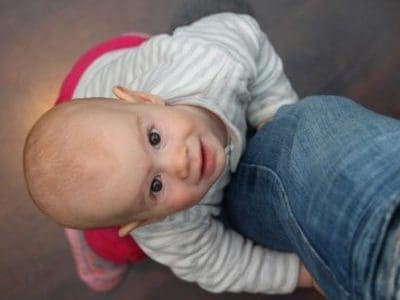
Psychology of a child at 9 months
The baby begins to carefully observe not only the faces of adults, but also their actions. Now he can imitate his parents, for example, trying to “cook” like mom or “shave” like dad. The baby should be encouraged to act independently: let him drink from a cup, offer him a spoon during lunch, put on and take off a hat. The child recognizes himself in the mirror and can distinguish his reflection from the reflections of other people.
Useful: Development of a nine-month-old baby - skills, habits and abilities
The baby willingly repeats sounds and imitates the voices of animals. Some children at 9 months are able to say a few simple words. A 9-month-old baby's favorite game is hide and seek. Now he can look for his mother, who is covered with a scarf, and hide himself. Children also love to throw a toy on the floor and wait for it to be picked up so they can throw it again.
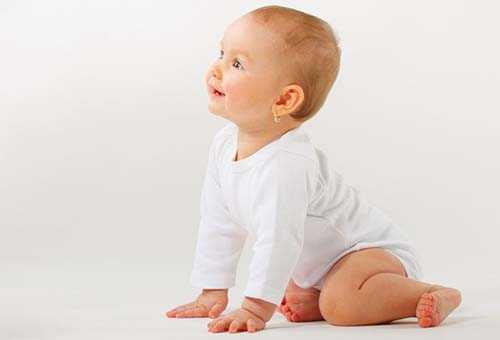
A nine-month-old baby's sitting skill is already well developed: the baby sits straight without losing balance
Baby development test at 9 months
- A child at nine months should be able to sit without parental support, try to stand up on his own, crawl for toys, hold a glass or mug with both hands, and grasp objects with two fingers.
- In a position on the stomach, the baby should reach for the object of interest and crawl towards it. When sitting, the baby should be able to turn and grasp an object from the side or behind him.
- The child must imitate the gestures and actions of adults. If you show him any simple individual actions, he will be able to repeat them.
- If you try to take a toy away from a baby, he will hold it tightly, push away the adult’s hands and pull it towards himself, expressing dissatisfaction.
- The speech of a nine-month-old toddler should contain repeating syllables.
- The baby must respond to his name, and also distinguish people close to him from strangers.
If the baby lacks at least one of the skills listed above, he should be shown to a doctor who will confirm or deny the developmental delay.
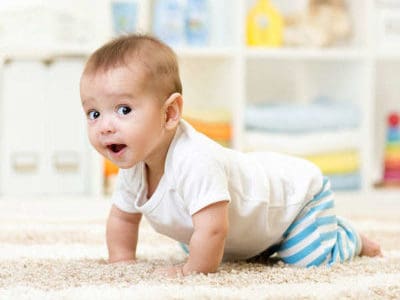
Features of child development at 9 months
The most important change at 9 months of age is the strengthening of the muscles of the shoulders and hips, ligamentous apparatus, and the development of neuromuscular coordination. This has to do with preparing the body for walking. In the ninth month, the baby also experiences other physiological changes:
- Development of sense organs. This includes improving the toddler's auditory perception and the ability to pronounce sounds and compare them with certain events, for example, the clinking of pots with dinner.
- Eruption of incisors. These teeth appear first on the upper jaw, and on the lower jaw a little later.
- Movements. Almost any baby is actively developing by the age of 9 months - he can crawl, stands confidently, and gets up independently from a lying position. The small muscles of the hands already make it possible to hold a spoon and teach the baby to eat with it and pick up small objects. The little ones move and point their fingers, reaching for interesting objects.
Physiological development
It is possible to determine whether the development of a 9-month-old child is at the proper level using several parameters. They are slightly different for boys and girls:
- Baby's growth at 9 months. For a boy this figure is 71.2-72.3 cm, and for girls – 68.5-70 cm.
- Baby's weight at 9 months. Babies do not gain weight as actively anymore due to movement. The body weight of boys of this age is considered normal if it varies from 9 to 9.5 kg. For girls, the same figure is 8.2-8.7 kg.
- Head size. Its average circumference for boys and girls can be 43.8-45 cm.
- Chest circumference. Values of 46.6-47.2 cm are considered normal.
Psycho-emotional behavior
It’s not just the baby’s body that is actively changing. According to the mental development calendar, a child of 9 months can also do a lot. This can be seen from the following points:
- Speech of crumbs. The baby begins to pronounce syllables, making short words from them.
- Hearing. The baby already knows his name and reacts animatedly, turning his head or smiling. The baby understands when they ask for something, for example, to get or take even a small object.
- Emotions. A baby at 9 months of development is already able to express indignation, resentment, anger, joy or surprise.
- Gestures. The baby nods his head, answering “yes” or “no.”
- Games. If you hide from your baby, he will be able to find you, even if you are not visible, by a rustle or voice.
- Cloth. The baby tries to help pull on his pants or T-shirt, sticking his arms or legs through.
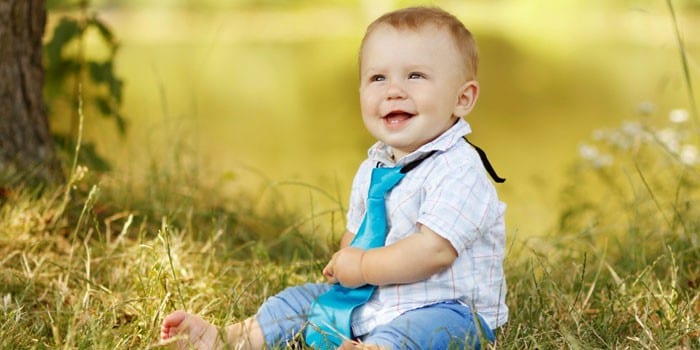
Baby's diet at 9 months
If the child is still breastfed, he should continue to be breastfed, introducing new foods into complementary foods. Breast milk or formula should make up ¼ of a child’s daily menu at this age.
If complementary feeding was introduced at six months, then by this age three feedings should be replaced with regular food, and the child’s menu should contain the following products:
- Vegetable puree 180 grams;
- Fruit puree 80 grams;
- Porridge 180 grams, meat 50 grams;
- Yolk ½ part twice a week;
- Cottage cheese and kefir 40 grams;
- Wheat bread or cookies 5 grams;
- Butter and vegetable oil 5 grams each;
- Juice 80 grams;
- Fish 50 grams.
Cottage cheese diluted with kefir should be given to the baby before bedtime. From the beginning of the ninth month, you can give your baby steamed meatballs made from lean meat. You can puree several types of vegetables and add greens to it.
Porridges can also consist of several grains. If the child tolerates oatmeal and wheat porridge well, they are also introduced into the diet. It is better to refuse semolina porridge for now, as it is too heavy for the baby’s stomach. It should be introduced starting from one and a half years.
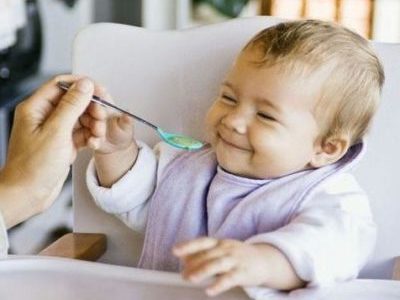
How to develop a child at 9 months?
The development of a child at 9 months largely depends on the parents. However, not only in the ninth month. The most important rule is not to limit the child’s knowledge of the environment, and to protect this very environment.
Even though the baby is already grown up, carry him in your arms as much as you can afford (or as long as your back can allow). Maximum close contact with a baby up to a year and even more is the key to a wonderful relationship with him in the future.
In the development of motor skills, the main task is to prepare the child for upright walking. Strengthening the muscles of the legs and back - these are our goals.
Exercises on a fitball, gymnastics, swimming in the bathtub, stimulation of crawling - all these activities are aimed at strengthening the muscle corset and developing coordination in the baby.
Learning to crawl is also an important task. This expands the area of surrounding space available for exploration. By crawling and moving, the baby learns to determine the position of his body and becomes more familiar with its control.
Subsequently, children who crawled a lot in infancy are better oriented in unfamiliar places, it is easier for them to find shortcuts and master new routes.
To encourage your baby to crawl, lay him out on the floor more often and place his favorite toys in front of the baby. So, trying to get them, the baby will try to crawl closer. Move the toys further and further each time. Every day the child will crawl better and better.
A sensory box will help develop fine motor skills. It is a container filled with various objects.
Everything that is in such a box must be safe for the child.
Most of the space can be filled with dry beans or large pasta, for example. Small toys will help supplement the contents. It will be interesting for the baby to dig around, sort through all this variety and find pleasant surprises.
Show your child how to play Ladushki, Magpie-Crow and Peek-a-boo. These simple games from Soviet childhood will add even more variety to your leisure time together.
Be sure to talk to your baby, read poems to him, recite nursery rhymes, sing before bed. Now the child will not be able, of course, to repeat all these words after you. But later, around the age of two, you will be surprised at his vocabulary.
Buy small books made of thick cardboard or fabric and let your baby flip through the pages himself.
Sleep-wake schedule
At nine months old, the baby sleeps twice a day for two hours. The toddler's night rest is 10 hours. The rest of the time he is awake. By nine months, some children's daytime routine changes. This happens because the child begins to sleep longer at night and wake up later, as a result of which daytime sleep shifts slightly. But not everyone experiences such changes. Most babies play and sleep in the same way as before.
Those children who are breastfed wake up at night and ask to be fed. However, they do this not because they want to eat, but because they need psychological closeness with their mother. This behavior will continue until the woman weans the baby. In addition, infants at this age may experience sleep problems.
They are connected with the fact that children deliberately stretch the time allotted for wakefulness as they want. They are already clearly aware of when it is day and when it is night. They also understand well that people sleep at night and lead active lives during the day. To stabilize the child’s routine, you should clearly distribute the hours of sleep and wakefulness and ensure that he does not get overtired during games.

Parental help
Even if it is no longer as easy to carry a nine-month-old baby in your arms as before, parents should continue to do so. Before the child begins to walk independently, carrying in the arms is a mandatory factor influencing the correct psycho-emotional development.
It is necessary to continue to improve speech skills. You need to talk more with your baby, read books to him and look at bright pictures. With him it is necessary to learn short poems and nursery rhymes that have repetition of phrases, syllables and words in the context. When looking at pictures of a toddler, they must be discussed, asking him to show certain objects that are depicted there. For this purpose, you can use thematic cards with pictures.
You also need to pay a lot of attention to crawling skills and do everything to improve them. You need to roll the baby blanket into a roll and push it under the baby's chest. Then it should be lifted by the ends of the blanket to help the baby crawl to the toys. When the baby crawls, you need to create alternate support for his legs. This technique will help him master cross crawling faster. If the child has already mastered this skill well, he can buy a house with a tunnel. The baby will be delighted with such a toy and will begin to independently move from the house to the tunnel and back. You can also make such a toy from cardboard boxes.
Parents should show their child how to build towers from blocks or build a pyramid. Although the baby will not yet be able to imitate adults, it will be very interesting for him to watch the process. He can try to stack cubes on top of each other or put pyramid rings on a stick, thus improving his skills and abilities. After the tower is built, the child must be asked to destroy it. At the age of nine months, babies really enjoy this activity and they love to watch how objects fall and crumble. When the tower is destroyed, parents should ask the baby to put the cubes in a box.
Getting to know the world around you
From the age of nine months, a child should begin to be introduced to toilet paper. First you need to show how to unwind a roll. The child will really enjoy tearing it, crumpling it and scattering it around. This warm-up is very useful for developing fine motor skills. You can also attach a piece of tape to your toddler’s hand and ask him to tear it away from you. Such activities will also cause delight.
Regardless of the gender of the child, he needs to purchase a doll and the more similar it is to a real baby, the better. Parents should put the baby doll on a high chair and ask the child to show which part of the toy’s body is, voicing each of them independently. After this, you need to ask the baby to show all the listed parts of the doll’s body on himself.
Child development during play
You should not stop playing while taking a bath.
You need to show your child how to pour water from one glass to another. It is necessary to pour semolina into a large bowl and bury small objects in it, inviting the child to find them by rummaging in the cereal. For the baby you need to make a separate box and put objects from different materials there so that he can develop his tactile sensations. However, it should be remembered that all of them must be safe for the little one.
You need to continue playing “Ladushki” with your child, including funny and catchy children’s songs during the game. At nine months, the baby can already crawl and sit well, for this reason all previously performed exercises should be complicated by adding exercises with gymnastic equipment: plastic rings, balls and wooden sticks.
You need to communicate with a nine-month-old baby while playing. This is very important to him. Care should be taken to ensure that each room has a safe set of objects that can be given to the child to play with. Parents can come up with their own entertainment for the baby or ask him what he would like to play. By his actions they can understand what exactly he wants. It is necessary to allow the child to start the game first, so he can be taught to be independent and responsible for his decisions.
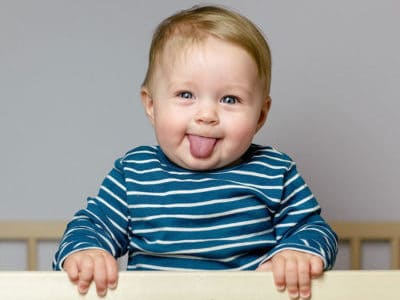
Child development at 9-10 months
Meshcheryakova S. Yu.
By 9-10 months, the child can already crawl well, sit down and sit independently, stand up holding onto support and stand steadily, step along the barrier, some babies begin to walk. At this age, the baby sleeps approximately 14.5 - 15 hours a day: two daytime naps of 2 - 2.5 hours and a night sleep of 10 - 11 hours. Feeding is carried out 4 - 5 times a day, breaks between feedings are 4.5 - 3 hours, depending on the individual needs of the child.
With the child gaining freedom of movement, parents have more worries: an inquisitive baby wants to touch, examine, and taste everything. Remove all dangerous objects, put plugs in electrical sockets, make sure that medications, detergents, and vinegar are kept out of the reach of children. However, often adults, worried about the safety of the baby, forbid him everything, lock cabinets, bedside tables, and seal drawers with tape. Numerous prohibitions fetter the child’s initiative and interfere with the development of his interest in the world around him. It is better to fill the spaces available to the child in the room with toys and objects that he can explore freely.
At this age (as before, starting from 6 months), joint activity with objects with adults plays the most important role for the child’s mental development. To communicate with people around them, children already use not only facial expressions, but various movements, sounds, actions, postures, and gestures. The child points his finger at an object that he wants to pick up, but cannot reach; puts a toy with which he wants to play in the adult’s hand; pretends to start the top, encouraging his mother to do it; tugs an adult busy with his own business by the sleeve to attract attention to himself; turns away and crawls away if he doesn’t want to get dressed, etc. Often children, sitting in a chair, throw toys on the floor and, with gestures and demanding sounds, ask the adult to pick them up. The baby throws the picked up toys again, and this can continue for a very long time. You should not be angry with your child for this, because in this way he is trying to involve you in a joint game.
Be sure to set aside time to play with objects together with your child: show a variety of actions with them, encourage your child to act with you. At 9 - 10 months. The baby, as before, actively examines surrounding objects and toys: examines, licks, bites, twirls in his hands, touches parts, moves and knocks on the table surface. But now he can master more complex actions: opening and closing the lid of a box, putting small molds into each other, transferring objects from one container to another.
In the process of mastering various actions with objects, the child’s intellectual development occurs. Parents should make sure that the baby is surrounded by objects and toys of different sizes, colors and shapes, made from different materials. A rich and varied subject environment stimulates the baby to various movements and actions, contributes to the enrichment of the child’s sensory experience and the development of thinking. The baby is already trying to pick up and push objects of different shapes and sizes into the appropriate hole in the cube, connect and disconnect the links of a chain made up of plastic parts with holes, disassemble and assemble a nesting doll. Such actions contribute to the formation of ideas about the whole and the part, about shape and size, and stimulate the development of perception, attention, and memory.
Toys should include wooden and plastic cubes; rubber and foam animals and balls; molds that can be nested inside each other or filled with balls; rubber and wooden hammers; pyramids, nesting dolls, construction kit parts, wind-up toys; toys - musical instruments: tambourine, barrel organ, bells, metallophone. Educational toys can not only be bought in the store, but also made by yourself from scrap materials. For example, fill a plastic bottle with peas and screw on the cap - you will get an interesting rattle. Sew bags and dolls from different fabrics, stuff them with different materials - cotton wool, beans, small cereals. Make boxes with holes into which you can put different items. Also suitable are mother's bags with different fasteners, an old telephone or radio, large buttons, spools, ribbons, ropes, laces, which can be put in craft boxes with different compartments. Make sure that your baby always has a choice of toys and that he is interested. As soon as interest in a toy wanes, offer your child something new.
With your help, your child can master quite complex actions and learn to use objects in a much more varied way than he can in independent activities. At 9 months, the child already coordinates his actions well with the actions of an adult: building a tower with his mother, handing a cube, alternately rolling a ball or a car with his father. While getting dressed, the baby also tries to act together with the adult: he holds out an arm, a leg, hands over tights, shows where to put on a shoe.
In no case should educational games be turned into a situation where, having given a model, an adult demands that the child reproduce it, and even scolds him for incorrect actions. There is no need to demand from your child an exact imitation of your actions, he is not yet capable of this. The game should remain a game: interesting, desirable, joyful. Gradually, the baby learns to perform new actions independently. He will become more focused and will play for a long time, enjoying the game.
Be sure to provide the child with the opportunity to take initiative, respond to the child’s proactive manifestations: give a toy, perform actions with objects at his request, bring an object of interest to the baby, name it, tell about it.
At about 9 months, a moment comes when the baby begins to focus on your assessment of his actions. This is expressed in the fact that he repeats the approved action and stops the condemned action, rebuilding it; rejoices at rewards and becomes upset, angry or offended when reprimanded; may do something “out of spite”, contrary to an adult’s prohibition. The baby is already guided by the adult’s assessment: he puts the ring of the pyramid on the rod - and looks at his mother, waiting for praise. Your assessment of the child and his actions becomes especially important, so you need to be very responsible with rewards and reprimands. In communicating with adults, the child experiences the success (or failure) of his activities, based not only on his own experience, but also based on the assessment of an elder. That is why it is so important to involve the baby in joint play with an adult, and not leave him alone with toys for a long time. The child loses interest in the subject as his own capabilities are exhausted, but the example and assessment of an adult will give him new horizons of activity, and rewards will increase the feeling of confidence. The child rejoices at a successfully completed action and strives to share the joy with an adult. Rejoice in your child’s successes with him, praise him.
Adult assessments are the most important tool for regulating a child’s behavior, but parents must use them correctly, otherwise the effect may be exactly the opposite. A very obedient and “unwillful” child often turns out to be constrained and passive.
It should be remembered that a baby is a very inquisitive creature. After all, what he is doing is not self-indulgence for him (as it often seems to adults), but a serious activity—comprehension of the world around him. Trying to satisfy his interest, he may break a toy, spill soup with an awkward movement, or drop a cup.
It is sometimes necessary to use prohibitions and reprimands, but this must be done carefully. At this age, children are not able to regulate their behavior, guided by verbal demands and prohibitions. It is better to distract the baby and switch the child to a safer or more interesting subject. It must also be borne in mind that praise is much more informative than blame: when scolding a child, we tell him what he cannot do, but we do not tell him anything about what and how he can do it.
If you do scold a child for something, do it in a calm, friendly tone, addressing the reproach to the child’s actions, but not to his personality. Say, “You did something bad,” but don’t say, “You’re bad.” Try to explain to your child the meaning of the prohibition or his offense. Be sure to end the conversation with the words “You are so good, I love you so much, but you did something bad and upset me.” Make sure that when communicating with your child there is more praise and encouragement than prohibitions and blame.
At 9-10 months, the baby already understands speech quite well, performs simple actions at the request of an adult, for example, “take the pussy, give me a spoon, show where mom, dad, grandma are,” etc. The baby himself uses babble to communicate. Children with whom their parents communicate a lot, show and name objects, play joint games, at 9 - 10 months. begin to pronounce the first words, for example, “me” - ball, “kh” - cat, etc.
Be sure to organize speech games with your child. When looking at images of animals, it is useful to name them and pronounce sounds that imitate the “speech” of a particular animal. For example: “This is a frog, it says qua-qua. And this is a mouse, it squeaks subtly pee-pee-pee.” These onomatopoeias contribute to the development of speech hearing. Over time, the child himself will begin to imitate and even answer the question “How does a mouse squeak?” These games are very useful for mastering the intonation structure of speech - a bear growls in a bass voice, a mosquito buzzes, a cow moos, etc. Speech games are also important for the development of actions following the example of an adult.
Looking at pictures and illustrations in books is very useful for cognitive development. He himself can show where the fish, bunny or bird is in the picture. If a child makes a mistake, do not correct him immediately, do not say: “No, it’s not a bunny, it’s a bird,” but say, “Well done, you showed the bird, and I’ll show you the bunny.”
By 10 months, the child already has an idea of his appearance and recognizes himself in the mirror, without confusing himself with his reflection. Children play with their reflection for a long time, performing various actions: bringing their face closer and further away from the mirror, sticking out their tongue, making grimaces, laughing, etc. The child should be given the opportunity to use the mirror, hang it so that the baby can see himself in full height. Teach your baby to find and show different parts of the face at yourself, at your mother’s, doll, or teddy bear: forehead, nose, eyes, lips, cheeks, ears, etc.
Continue playing nursery rhyme games with your child:. “Ladushki”, hide and seek, “Magpie-Crow”, “Baba sowed peas”, etc. All these games delight the child, deepen attachment to an adult, promote the development of attention, imitation, and speech.
Bibliography
To prepare this work, materials from the site https://www.portal-slovo.ru/ were used
Information about the work “Child development at 9-10 months”
Section: Psychology, pedagogy Number of characters with spaces: 10682 Number of tables: 0 Number of images: 0
Similar works
Mental development of a child in infancy
58850
0
0
... period, the child begins to listen to the adult’s speech, turn his head towards the human voice, some babies react with a cry to the crying of other children. 2. Actually infancy. 2.1. The role of communication with adults in the development of a child. The life of a baby depends entirely on an adult. The adult satisfies the organic needs of the child - feeds, bathes, turns him from one side to...
Psychological support for the harmonious development of the child
69451
0
0
... in the first of which (control) no special psychological preparation was carried out; the second group (experimental) regularly engaged in targeted psychological preparation for the birth and harmonious development of a child. Observations were made of their children born and outcomes 7-10 months after birth; the reaction of children in infancy to psychological support...
Organization of nursing monitoring of child development
49909
15
1

...) for vaccination, as well as for mild manifestations of skin and respiratory allergies, higher health authorities are not informed. These reactions are recorded in the child's developmental history, the child's or outpatient's medical record, the immunization certificate, and the clinic's immunization log. Each case of post-vaccination complication requiring...
Psychophysical development of the child
15987
0
0
...handle the cup yourself. Show your baby how you drink from a cup yourself. The object lesson meant a lot to him. Six months Period of imitation From the age of six months, a new stage in the child’s development begins. From this time on, the so-called period of imitation begins. Of course, the child is still too young to behave the way an adult does. Outwardly, a child may even...
